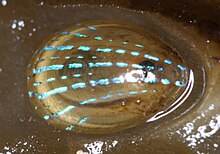| Patella pellucida | |
|---|---|

| |
| Scientific classification | |
| Domain: | Eukaryota |
| Kingdom: | Animalia |
| Phylum: | Mollusca |
| Class: | Gastropoda |
| Subclass: | Patellogastropoda |
| Family: | Patellidae |
| Genus: | Patella |
| Species: | P. pellucida |
| Binomial name | |
| Patella pellucida Linnaeus, 1758 | |
| Synonyms | |
| |
Patella pellucida, common name the blue-rayed limpet, is a species of small saltwater limpet, a marine gastropod mollusc in the family Patellidae, the true limpets.
Range of distribution
This limpet occurs off the eastern Atlantic coasts from Iceland and Norway, to Portugal. It is absent from the Baltic Sea, East Denmark, Belgium and the Netherlands.
Shell description
Up to 15 mm long when fully grown, this species is easily identified by its translucent amber shell with brilliant blue spots running in lines across the top of the shell.


Habitat
The blue-rayed limpet lives primarily on Laminaria (kelp) in strong flowing water but also on Fucus serratus on the lower shore, down to about 30 m.
Life habits
The larvae of this limpet species settle and metamorphose on the algal frond. Here it feeds on its host’s tissue using its radula, leaving small depressions in the frond.
As the limpets grow larger, they move down the stipe of the seaweed towards the holdfast, where they establish themselves by excavating a depression. This can weaken the holdfast, eventually resulting in the seaweed being dislodged by storms. The seaweed is often washed ashore, with the blue-rayed limpets still in place.
References
- ^ Bouchet, P.; Gofas, S. (2011). Patella pellucida. Accessed through: World Register of Marine Species at http://www.marinespecies.org/aphia.php?p=taxdetails&id=147459 on 2011-12-31
- Gofas, S.; Le Renard, J.; Bouchet, P. (2001). Mollusca, in: Costello, M.J. et al. (Ed.) (2001). European register of marine species: a check-list of the marine species in Europe and a bibliography of guides to their identification. Collection Patrimoines Naturels, 50: pp. 180-213
- Campbell, A.C. 1984. The Country Life Guide to the Seashore and Shallow Seas of Britain and Europe. Country Life Books. ISBN 0-600-34396-0
- Lewis, J.R. 1964. The Ecology of Rocky Shores. The English Universities Press Ltd.
External links
- General biology of Blue-Rayed Limpets
- Serge GOFAS, Ángel A. LUQUE, Joan Daniel OLIVER, José TEMPLADO & Alberto SERRA (2021) - The Mollusca of Galicia Bank (NE Atlantic Ocean); European Journal of Taxonomy 785: 1–114
- Photos of Patella pellucida on Sealife Collection
| Taxon identifiers | |
|---|---|
| Patella pellucida | |